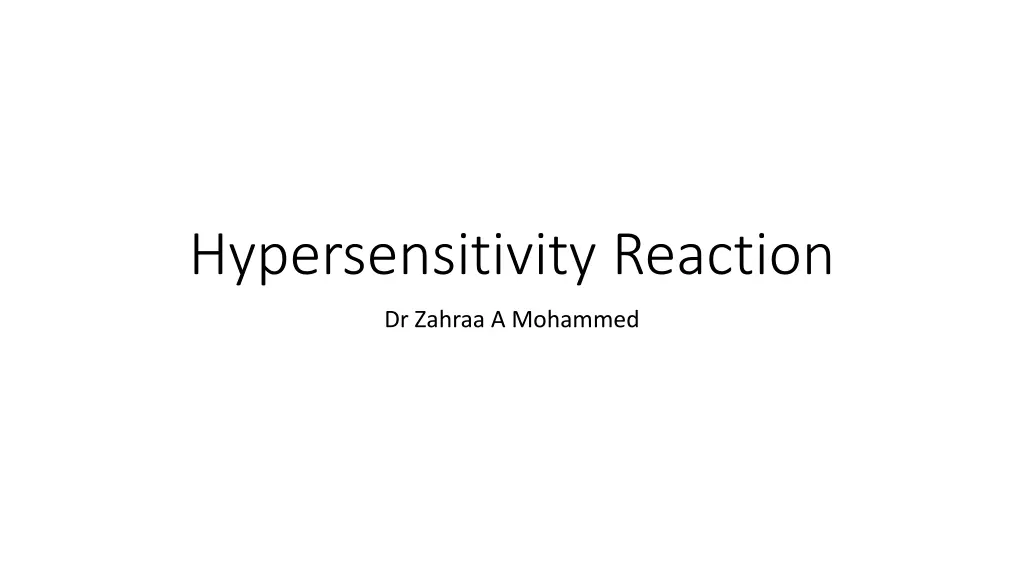
Understanding Hypersensitivity Reactions and Transfusion Complications
Learn about type II antibody-mediated cytotoxic hypersensitivity, ABO blood groups in transfusion reactions, and the treatment for managing complications. Explore the causes, mechanisms, and consequences of these immune responses.
Download Presentation

Please find below an Image/Link to download the presentation.
The content on the website is provided AS IS for your information and personal use only. It may not be sold, licensed, or shared on other websites without obtaining consent from the author. If you encounter any issues during the download, it is possible that the publisher has removed the file from their server.
You are allowed to download the files provided on this website for personal or commercial use, subject to the condition that they are used lawfully. All files are the property of their respective owners.
The content on the website is provided AS IS for your information and personal use only. It may not be sold, licensed, or shared on other websites without obtaining consent from the author.
E N D
Presentation Transcript
Hypersensitivity Reaction Dr Zahraa A Mohammed
Type II Antibody-Mediated Cytotoxic Hypersensitivity is caused by IgG and IgM antibodies directed against membranes and cell-surface antigens. Antibody bound to a cell-surface antigen can induce death of the antibody-bound cell by three distinct mechanisms.
Type II Antibody-Mediated Cytotoxic Hypersensitivity First, certain immunoglobulin subclasses can activate the complement system, creating pores in the membrane of a foreign cell. Secondly, antibodies can mediate cell destruction by antibody dependent cell-mediated cytotoxicity (ADCC), in which cytotoxic cells bearing Fc receptors bind to the Fc region of antibodies on target cells and promote killing of the cells. Finally, antibody bound to a foreign cell also can serve as an opsonin, enabling phagocytic cells with Fc or C3b receptors to bind and phagocytose the antibody-coated cell
Transfusion Reaction ABO blood groups form the dominant blood group system in humans. The major blood group antigens A and B are expressed on the surface of human red blood cells. Th e antigenic groups A and B are derived from the H substance by action of glycosyl transferases encoded by A or B genes respectively . For unknown reasons, everyone is sensitized early in life to make natural IgM Antibodies directed toward ABH antigens are termed isohemagglutinins Antibody attaches to RBC and initiates complement system to lyse RBC individuals with mismatched blood-group antigens, lysis of the transfused RBCs results in the rapid release into the serum of free hemoglobin, which is subsequently converted into the toxic metabolite bilirubin This usually results in chills, nausea, clotting within blood vessels, fever and pain in the lower back due to massive intravascular hemolysis
The treatment usually recommended for such reactions is immediate termination of blood transfusion and flushing out accumulated hemoglobin by urine flow with diuretic. Transfusion reaction with minor blood antigens usually occurs when individuals receive repeated transfusions of ABO-compatible blood that is incompatible with other blood group antigens. Such repeated transfusions generate antibodies against blood cell antigens. This is common in patients who are given repeated blood transfusions, as in pregnancy or sicklecell anemiai
Hemolytic disease of newborn (HDNB) Hemolytic disease of newborn (HDNB) The Rhesus (Rh) blood group forms the other major antigenic system. The most commonly involved antigen is RhD. It is carried by red blood cells. Children born to RhD- mother and RhD+ fathers may express RhD on their red blood cells. During the firrst pregnancy with RhD+ foetus, RhD- mother is not exposed to enough foetal blood cells to activate B-cell response against RhD antigen. At the birth of the first child, separation of the placenta from the uterine wall occurs, which releases a large number of red blood cells carrying RhD antigen into the mother. These foetal cells activate Rh-specific plasma cells and memory cells in the mother.
These antigen-bearing cells are cleared from the mothers bloodstream by maternal IgM antibodies but memory cells remain in circulation in the mother s body. Any subsequent pregnancy with Rh0D+ foetus will induce anti-RhD IgG which are able to cross the placenta and destroy foetal red blood cells. Jaundice, hepatosplenomegaly and, in untreated infants, bilirubin encephalopathy may occur. The consequences of such transfer is the development of mild or severe anaemia characterized by haemolysis in the foetus. This disease is called erythroblastosis foetalis or hemolytic disease of the newborn.
This disease can now be entirely prevented by administering prophylactically anti-RhD antibodies to the mother within 72 hours after the first delivery. These antibodies called rhogam (gamaglobulin against RhD) bind any stray foetal red blood cells that enter the mother s circulation at the time of delivery
Drug Drug- - induced Hypersensitivity induced Hypersensitivity Certain antibiotics (e.g., penicillin, cephalosporins, and streptomycin), as well as other well-known drugs adsorb nonspecifically to proteins on red blood cell membranes, forming a drug protein complex induce formation of antibodies. This binding of antibodies on red blood cells induces haemolysis by activating the complement system, antibody- dependent cell-mediated cytoxicity and phagocytosis of red blood cells This red blood cell destruction or haemolysis causes the onset of anaemia. When the drug is withdrawn, the haemolytic anaemia disappears.






















